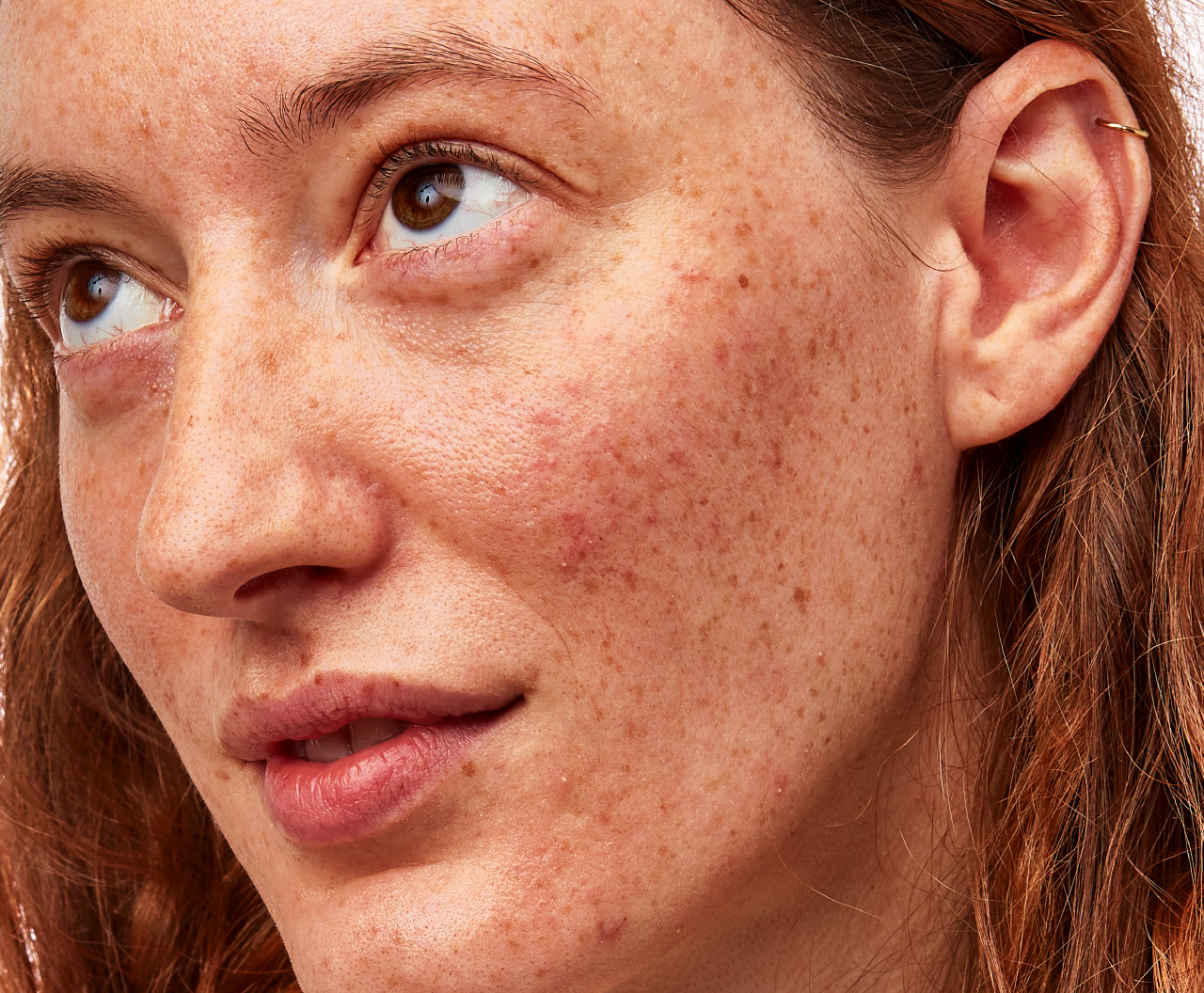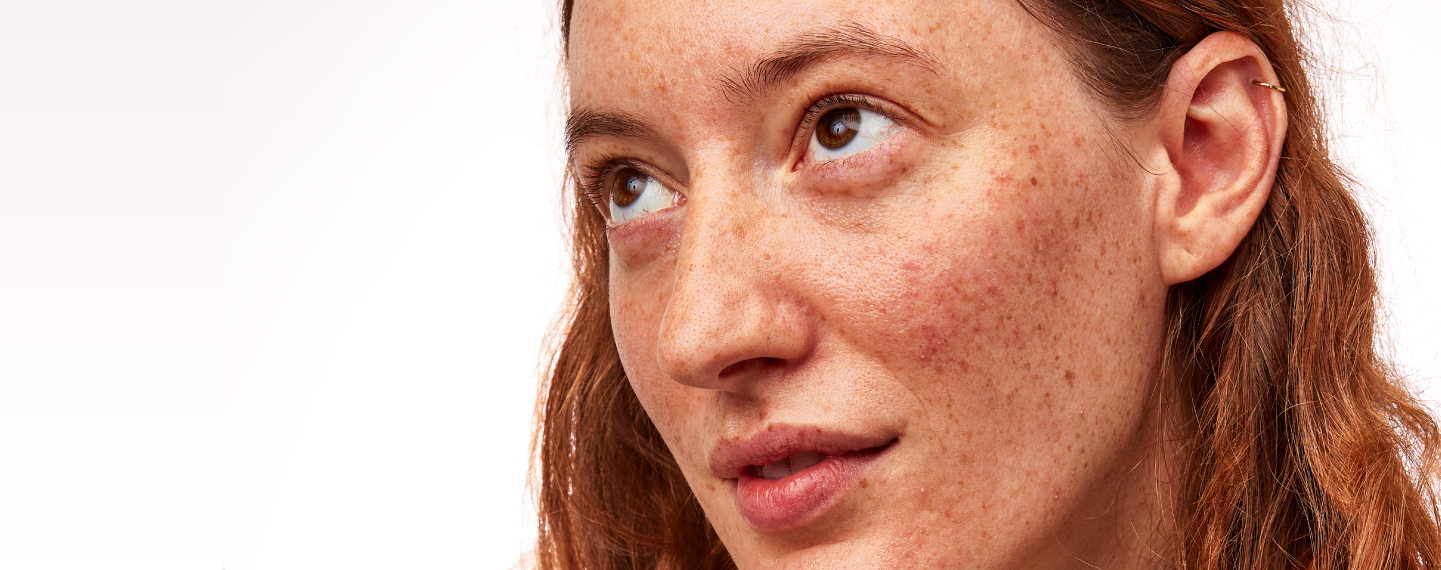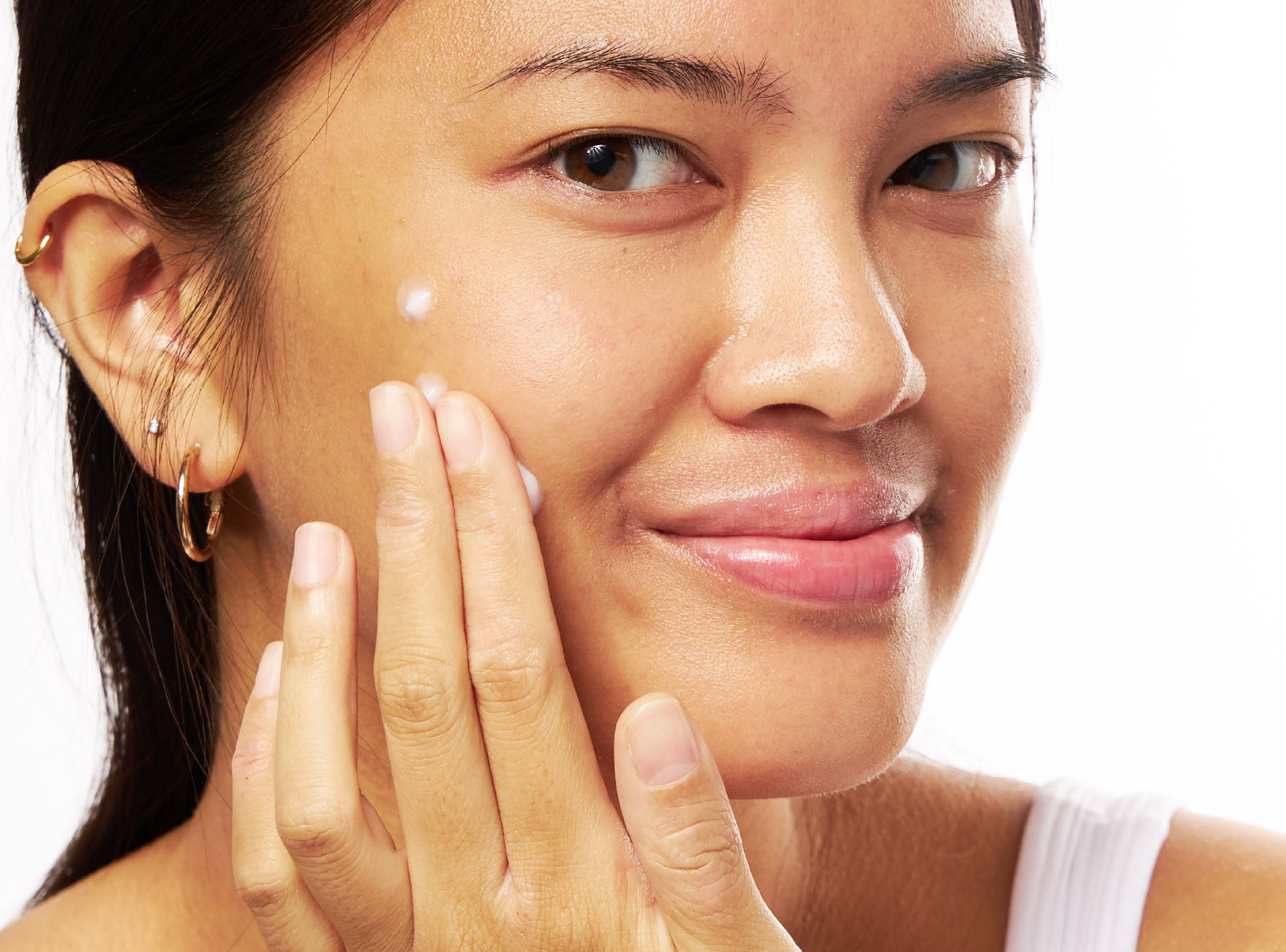Education
Blackheads on cheeks


SHARE
Education
Blackheads on cheeks
Medically reviewed by Kristin Hall, FNP
Written by Apostrophe Team
Last updated 4/1/2024
Acne can stand out anywhere, but it’s particularly annoying when it develops on your cheeks and other obvious, easily visible parts of your face.
Blackheads are a form of comedonal acne that develop when your hair follicles, or pores, get clogged with oil and leftover skin cells. Since your cheeks gather lots of oil, they’re a common location for blackheads and other types of acne.
While blackheads may not be as annoying as papules, pustules, and other inflamed acne, they can still have a negative effect on your skin and self-confidence.
Below, we’ve explained how blackheads can develop on your cheeks and other areas of your face. We’ve also talked about what you can do to quickly and safely get rid of blackheads and prevent them from coming back.
Blackheads: The Basics
Blackheads are a type of comedonal acne. Unlike the red, tender pimples you might get from time to time, blackheads usually aren’t inflamed, painful, or swollen.
Like other types of acne, blackheads develop when sebum and dead skin cells build up inside your hair follicles, or pores, and cause a blockage to develop.
The dark color of blackheads isn’t caused by dirt. Instead, it develops when the contents of a blackhead react to oxygen in the air.
Blackheads on your cheeks can be annoying, but they’re usually easy to treat with a mix of over-the-counter products and, if necessary, medication.
You can prevent blackheads from coming back by washing your face regularly, avoiding heavy skin care products, and using acne treatments to reduce the buildup of sebum and dead skin cells on your face.
What Causes Blackheads?
Blackheads and other types of acne form when the hair follicles in your skin, or pores, become clogged with a mix of sebum, dead skin cells, and other substances.
Sebum is a type of oil that’s produced by your skin. It’s secreted by your sebaceous glands and plays a key role in keeping your skin moisturized and hydrated. It also has antimicrobial effects that protect your skin against bacteria and other harmful pathogens.
Although sebum is important for your skin’s health and protection, when it builds up inside your hair follicles, it can cause blocked pores and acne.
A variety of factors control your body’s production of sebum, including your levels of certain sex hormones. When these hormones fluctuate, such as before and during your period, you may be more prone to developing hormonal acne.
Another factor that can contribute to blackheads is dead skin that’s left behind as a byproduct of your skin’s cellular turnover process.
In order to revitalize and repair itself, your skin constantly sheds its old cells and replaces them with new ones. This process is referred to as epidermal turnover.
As new cells rise from the base layers of your skin to the surface, the old skin cells detach and are shed off into the environment. On average, it takes 40 to 56 days for your skin cells to replace themselves through this process.
Sometimes, the dead skin cells left behind by this process aren’t fully shed. These can mix with sebum and contribute to clogged pores and acne breakouts.
Blackheads and whiteheads are two of the most common types of acne. They both develop via the same basic process. However, while whiteheads are pores that are fully clogged by dead skin cells and sebum, blackheads are clogged pores that have a small opening.
Through this opening, oxygen can come into contact with the debris inside the pore, causing it to darken in color.
Since your cheeks often get oily, they’re a common place for blackheads. Other common areas for blackheads include your nose, chin, and forehead, as well as other parts of your body.
If you’ve ever looked into the causes of acne, you may have seen mentions of bacteria such as Propionibacterium acnes, or P. acnes (now called Cutibacterium or C. acnes).
Some types of acne, such as inflamed acne, worsen and become inflamed when bacteria multiply inside a clogged pore. However, comedonal forms of acne like whiteheads and blackheads aren’t affected by this type of bacteria and usually aren’t inflamed.
How to Treat Blackheads on Cheeks
Since blackheads are caused by a combination of sebum and dead skin cells, most acne treatments for blackheads work by targeting sebum, skin cells, or both.
Some do this directly by washing away sebum or exfoliating their skin. Others do it by reducing your body’s production of sebum in the first place.
If you’re prone to blackheads that affect your cheeks, it’s important not to panic. Blackheads are a mild form of acne, meaning they’re usually easy to treat using over-the-counter products, acne medications, or a combination of the two.
Over-the-Counter Treatments for Blackheads
If you only have a few small blackheads, you may be able to get rid of your acne and clear your skin using over-the-counter products. Look for:
Facial cleansers. A good facial cleanser is an essential part of any skin care and acne prevention routine. Cleanser helps to strip away excess oils, dirt, and skin cells that can cause blackheads and other types of acne.
Alpha-hydroxy and beta-hydroxy acids (AHAs and BHAs). These ingredients can be found in many cleansers and other skin care products. They work by stripping away the dead skin cells that can build up on your epidermis and contribute to acne. Popular AHAs include citric acid and glycolic acid, while popular BHAs include salicylic acid. It’s important to use these products correctly to avoid irritating or drying out your skin.
Pore strips. These strips contain an adhesive that pulls sebum and dead skin cells from blackheads. While these provide temporary relief, they don’t actually do anything to treat acne and won’t have any effect on sebum or dead skin cell buildup. Since pore strips can affect your skin’s natural cell barrier, you may notice irritation if you have sensitive skin. While it’s okay to use pore strips occasionally, it’s best not to rely on them as a long-term treatment for blackheads. It’s also important to be careful when applying and using these products, as they may damage your skin if left on for too long or removed too firmly.
Prescription Medications
Although the idea of using prescription medication to treat blackheads might seem excessive, a range of mild, skin-friendly prescription medications are available that can get rid of comedonal acne without harming or irritating your skin. In addition to treating blackheads, these medications can also help to prevent papules, pustules, and other forms of acne. Some even offer science-backed anti-aging benefits.
Common prescription medications for acne include:
Tretinoin. Tretinoin is a topical medication that works by speeding up your skin’s cellular turnover process and unclogging your pores. Numerous studies have shown that it can assist in treating blackheads and other common forms of acne. Tretinoin is one of several ingredients that could be in your Apostrophe topical treatment, which is tailored specifically to treat your skin concerns.

PRESCRIPTION TRETINOIN
Target acne, dark spots, and signs of aging with this science-backed ingredient.
Hormonal birth control. Several combined birth control pills are approved by the FDA as acne treatments. These work by reducing your levels of hormones that can stimulate sebum production and cause acne.
Other acne medications. Several other medications are used to treat acne, particularly severe or persistent acne. These include oral retinoids such as isotretinoin and topical or oral antibiotics such as clindamycin, doxycycline, and others. While these typically aren’t used to treat blackheads alone, your healthcare provider may prescribe medication of this type if you have other, more severe, forms of acne.
How to Prevent Blackheads
After you’ve treated your blackheads, you can prevent them from coming back by making some simple changes to your skin care routine:
If you’re prescribed medication, continue using it after your skin clears. Acne can come back, meaning you might experience flare-ups if you’re prescribed medication for acne and stop using it. If you use acne medication, make sure to take it for the entire treatment period, even if your skin clears up early.
Wash your face regularly. Try to wash your face twice a day -- once in the morning and once before bed. You should also wash your skin after you exercise or do anything that causes you to sweat.
Avoid scrubbing your face aggressively. When you wash your face, apply products using your fingertips and use a gentle touch. Avoid scrubbing your face with a sponge, washcloth, or other items, as this can cause skin irritation.
Try not to touch your face. From your fingers to your phone, your cheeks often come into contact with other items and parts of your body, making them magnets for bacteria, oils, and other acne-causing substances. If you’re prone to blackheads and other acne on your cheeks, try to avoid touching your face. If you need to touch your face -- for example, to apply a skin care product -- make sure to thoroughly wash your hands first using soap and warm water.
Avoid holding your phone against your face. Several studies have found that phones are major hotbeds of bacteria, including some forms of bacteria that can infect your skin and cause acne-like symptoms. Your phone’s screen may also contain dirt and oils that build up over time. To keep your skin protected and prevent blackheads, use headphones or hold your phone an inch or two away from your cheek whenever you need to make or answer a call.
Don’t pop blackheads on your own. While blackheads might seem mild and easy to pop, this isn’t a good idea. When you pop a blackhead, you risk pushing the blockage deeper into your skin and making the acne worse. We get it — the temptation is strong. You can get some solid tips and tricks on how to keep your hands off your face in our guide to How to Stop Picking At Acne.
Shampoo your hair often. Oils from your hair can easily make their way onto your face, especially if you have long hair that touches your cheeks. Just like sebum, oils from your hair can clog your pores and cause blackheads. If you have oily hair, make sure to wash it regularly with shampoo to limit oil buildup and reduce your risk of developing acne.
Use non-comedogenic makeup and skin care products. Some cosmetics and other skin care products contain oils and other ingredients that can clog pores and contribute to acne breakouts. When you’re shopping for makeup and other skin care products, look for items labeled “non-comedogenic” or “oil-free.” These are formulated to be less likely to cause acne.
Don’t sleep in your makeup. Make sure to fully remove your makeup before you go to sleep, especially around your cheeks. If you’re prone to blackheads and other acne, use an oil-free, non-comedogenic makeup remover.
Wash your bedding regularly. Over time, oils and leftover skincare products can build up on your pillowcases and other bedding. When you sleep, these may clog your pores and contribute to blackheads and other acne on your cheeks. To prevent this, make sure to wash your sheets every week and your pillowcases once every few days.
In Conclusion
Although blackheads usually aren’t painful, they can be a serious annoyance when they develop on your cheeks and other highly visible parts of your face.
Luckily, blackheads are treatable. With a combination of over-the-counter products, good habits and, in some cases, medication, it’s almost always possible to get rid of blackheads and prevent them from having a noticeable impact on your appearance. You can learn more about dealing with blackheads and other types of acne in our detailed guide to the best acne medications.
Shop this post

Tretinoin
Like what you just read? Sign up for our email list to get the scoop on skincare science delivered straight to your inbox.

Education
What is milia?
What is milia? Today, we’re jumping into one type of bump that you may have heard about most commonly in infants — milia.
Read More
Education
Best moisturizer for acne-prone skin
If you have combination acne-prone skin, figuring out which moisturizer is best for your skin might be tough. In this guide, we break down the best moisturizer for combination, acne-prone skin.
Read More
Education
How to build a face care routine
As you get into skincare, it might seem overwhelming, especially trying to figure out the order you're supposed to apply products in. Below, we detail how to build a face care routine for your skin!
Read More